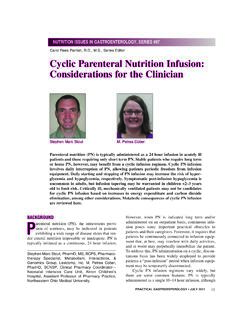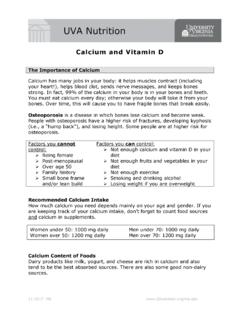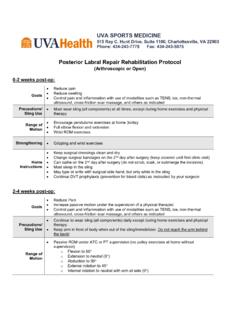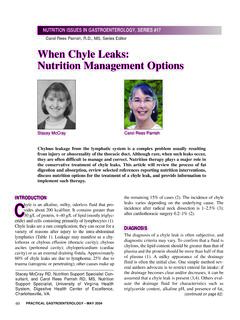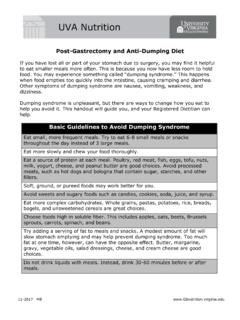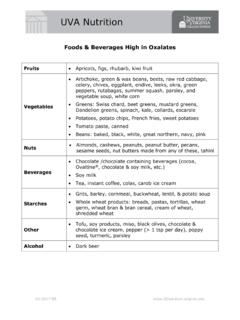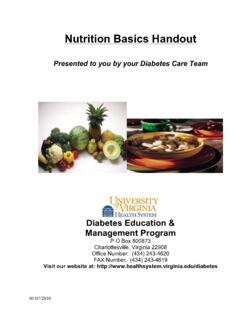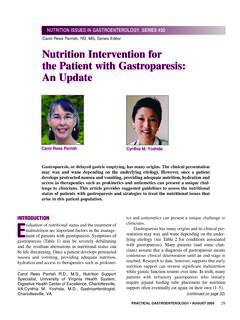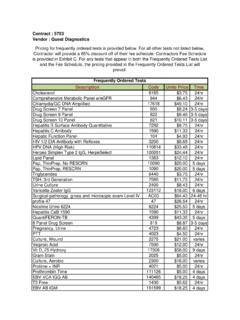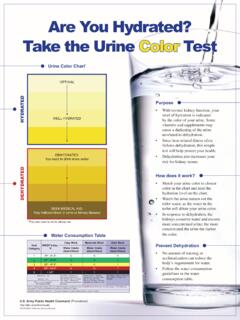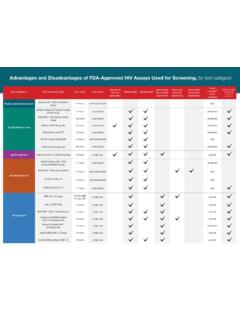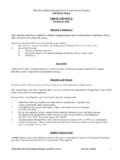Transcription of High Output Ileostomies: The Stakes are Higher than the Output
1 NUTRITION ISSUES IN GASTROENTEROLOGY, SERIES #190 Carol Rees Parrish, MS, RDN, Series Editor20 PRACTICAL GASTROENTEROLOGY SEPTEMBER 2019 NUTRITION ISSUES IN GASTROENTEROLOGY, SERIES #190 Meagan Bridges, RD Clinical Dietitian and Nutrition Support Specialist, University of Virginia Health System Charlottesville, VA Roseann Nasser, MSc RD CNSC FDC Research Dietitian - Nutrition and Food Services Pasqua Hospital - Regina, Saskatchewan Health Authority Carol Rees Parrish, MS, RDN Nutrition Support Specialist University of Virginia Health System Digestive Health Center Charlottesville, VAHigh Output Ileostomies: The Stakes are Higher than the OutputRecent years have seen a dramatic increase in readmission rates among patients with ileostomies who present with dehydration and/or kidney injury.
2 High readmission rates are often the result of a failure to anticipate what will happen after discharge. Preventing readmission and preserving kidney function in these patients starts with reliable and accurate data collection including not just stool Output , but urine as well and continues with detailed follow-ups to optimize medications, fluid, and food intake. Supporting patients through the entire process also requires educating them and equipping them with tools to gather and track their Output . As clinicians, it is incumbent upon us to develop and execute a practical plan for adequate hydration and Output management to not only prevent kidney injury, but also improve the quality of life for these NasserCarol Rees ParrishMeagan BridgesHis medications at the time of consult included a PPI BID, 5 mg Lomotil QID, 8 mg Imodium QID, Metamucil TID, cholestyramine BID, oxycodone PRN, and 50 mcg sandostatin q8h.
3 He is 6 2 and has maintained a weight of 250-255 lb for years. His BUN and creatinine were 28 and respectively, with a reported 24 hour urine Output of 1 liter during the winter months, but stated he sometimes goes a day or so without urinating in the summer. He also reports over 300 kidney stones the first one occurring within 3 months of his loop ileostomy - with over 20 lithotripsies, all of which were managed at an outside facility hence, the surgeon who performed the loop ileostomy was unaware of any of this. After years of failing to meet his hydration needs and repeated bouts of nephrolithiasis, he finally CASE STUDYA46-year-old male with history of ulcerative colitis (diagnosed at age 26), status post total proctocolectomy with J-pouch (1998), proximal diversion with loop ileostomy with 270cm small bowel remaining (2005), presented in 2018 following 5 days of emesis and high Output from his ileostomy, ultimately found to be secondary to a narrowing in his ileum causing outflow diarrhea.
4 NUTRITION ISSUES IN GASTROENTEROLOGY, SERIES #190 High Output Ileostomies: The Stakes are Higher than the OutputPRACTICAL GASTROENTEROLOGY SEPTEMBER 2019 21 NUTRITION ISSUES IN GASTROENTEROLOGY, SERIES #1903-fold increase in ileostomy Output between post-op discharge and readmission (an average of 13 days later).2 Another study found that patients had significantly decreased GFR at ileostomy closure compared to pre-op ileostomy creation for any Finally, Li et al. showed that 25% of patients with ileostomies develop CKD within 2 years, likely due to recurrent, sub-clinical clinicians, we are tasked with intervening not only to prevent kidney injury, but also to ease the other clinical and psychological burdens as well as quality of life challenges that so many patients with high- Output ileostomies face (Table 2).
5 High Output DefinedAs Table 3 shows, there can be many causes of high Output , which in turn may lead to dehydration and kidney injury. A normal, mature ileostomy should only make about 1200mL of Output each day (Table 4). Jejunostomies can initially put out up to 6 L, but this too will decrease with the help of medication. On the other hand, colostomies usually only put out 200-600mL/day. In the literature, high Output is loosely defined as > 1500mL/day. Acute Kidney Injury and DehydrationAs of 2011, expanded guidelines have been proposed based on serum creatinine levels and urine volume, widening the scope of what it means to have an AKI (Table 5).
6 Dehydration, however, is a bit more nebulous. While there is no single way to define it, one of the best indicators is whether a patient is able to make enough urine (>1200mL/ day). Other indicators are listed in Table 6. Note that dark urine can sometimes be a side effect of a particular medication, rather than a sign of dehydration. Make sure to ask patients lost his left kidney. During this admission, it was determined that he needed 3 L of IV fluids nightly to prevent dehydration and to protect his remaining kidney. INTRODUCTIONC ases like the one above are not uncommon among patients with ileostomies. As Table 1 shows, recent years have seen a growing focus on readmission rates for dehydration and/or acute kidney injury (AKI) among this population (possibly as a result of stipulations in the Affordable Care Act aimed to decrease hospital readmissions in general).
7 1 New ileostomy patients are often sent home well hydrated from IV fluids while admitted and with minimal Output owing to decreased post-op appetite and intake, but this often does not reflect what will happen after discharge when patients are left to hydrate themselves and their appetite and oral intake picks up. In one study, it was shown that patients readmitted for AKI presented with a Table 1. Readmission and Dehydration and/or AKI in Patients with IleostomiesYear Citation NDehydration &/or AKI*2001 Beck-Kaltenbach1510719%2002 Hallb k16 22232%2012 Gessler17 Hayden18 Messaris19 Nagle2025015460316118%20%7%16%2013 Paquette21 20117%2014 Gessler3 Glasgow23 Phatak24 Tyler25 30853294600719%39/33%11%9%2015 Villafranca26 4330%2016 Li4 Orcutt28 8410417%14%2017 Iqbal29 Fish30 2311365%41%2018 Justiniano31 26237%* Does not include ER visits/admissions at outside facilitiesTable 2.
8 The Clinical Burden of High- Output Ileostomies Low urine Output Dehydration Electrolyte Imbalances Nephrolithiasis AKI CKD Dialysis Fatigue Frequent leakages Peristomal skin complications Social isolation Reduced physical activity Depression Overall well-being22 PRACTICAL GASTROENTEROLOGY SEPTEMBER 2019 NUTRITION ISSUES IN GASTROENTEROLOGY, SERIES #190 High Output Ileostomies: The Stakes are Higher than the OutputNUTRITION ISSUES IN GASTROENTEROLOGY, SERIES #190discussion with the nursing staff to clarify the difference between I&O and Strict I&O. It is also very important that both floor and wound and ostomy nurses document if a patient s ostomy is leaking, or bursting, so all know that the ostomy volume recorded in the medical record is less than what the losses really are.
9 In general, goal urine Output should be around 1200mL (or in the case of kidney stone formers, at least 1500mL) each day. Ideally, a goal stool Output should be < 1500mL/ day, not just to reduce the risk for dehydration, AKI or kidney stones, but also to improve the patient s overall quality of life. Providing patients with the tools to measure both urine and ostomy Output is essential (see Figures 1-4).SodiumPatients with high ostomy Output are at risk for sodium depletion as jejunal and ileal effluent contain 80-140mEq sodium per liter respectively. It will be important to provide enough sodium in the patients IV fluids to reflect this and adjust as the Output is brought down under control.
10 One way to determine if your patient is sodium replete is to obtain a 24 hour or random urine Na level; < 10mmol/L suggests Na ,6 Osmotic vs Secretory DiarrheaSome patients who present with high Output will require differentiating between osmotic and if they have ever been admitted for dehydration (whether at your own or another outside facility) and/or been to the emergency department and received IV fluids or experienced a kidney stone. Treating and Preventing Dehydration: What to Do When an Ileostomy Patient is ReadmittedTreatment for dehydration will look different in ileostomy patients vs. those without ileostomies. In addition to fluid resuscitation with IV fluids, high Output ileostomy patients are often told to drink more by mouth.
